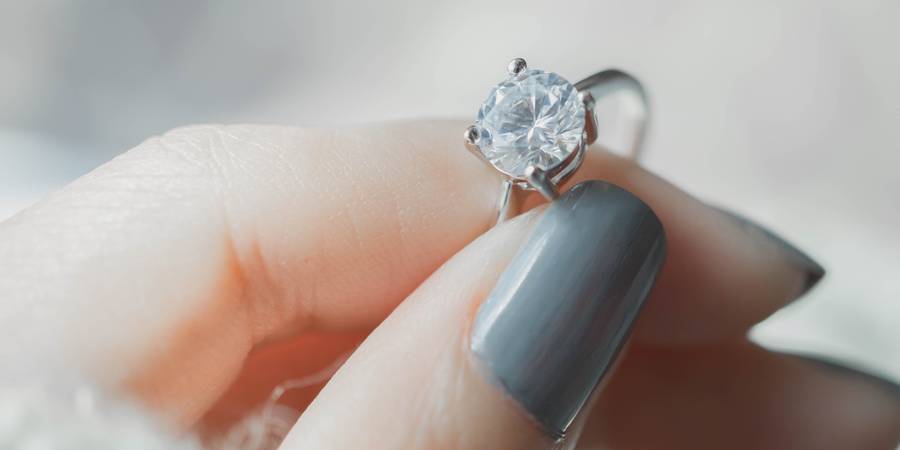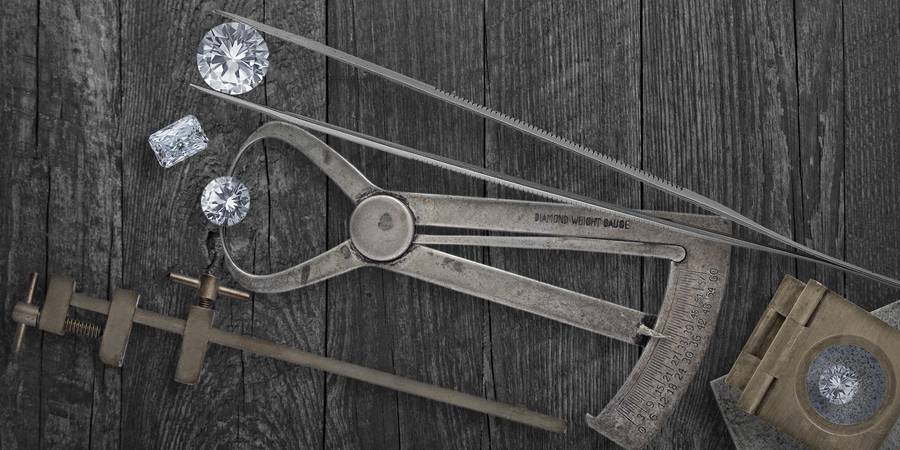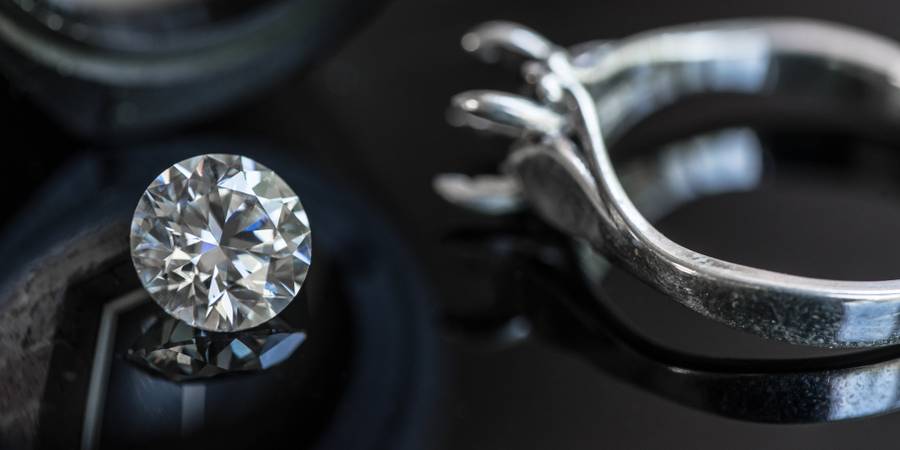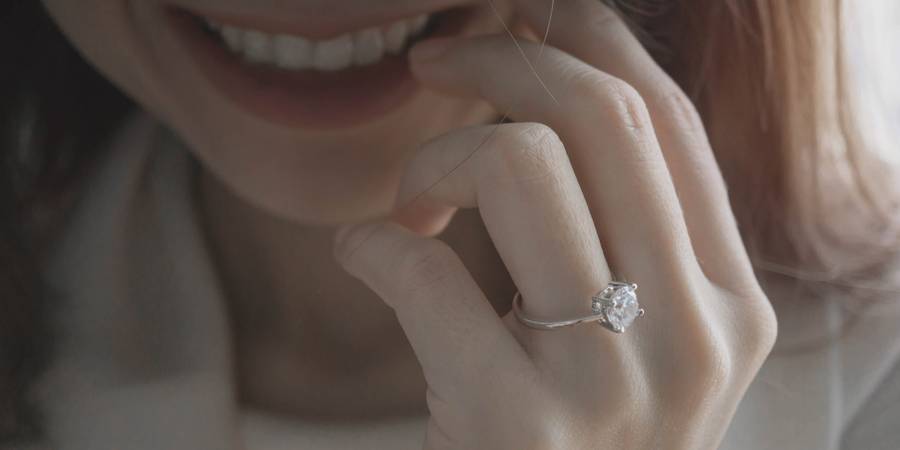In order to accurately assess the value of a diamond, it is important to understand the significance of its cut and color, and to consider its overall appearance.
The simplest approach to determine the market value of a diamond is to compare it to diamonds of the same carat weight and similar clarity, cut, and color grades. Conducting research online and establishing an average price can provide a rough estimate of the diamond’s value.
The Four C’s—cut, color, clarity, and carat weight—are the primary factors that determine the value of a diamond. While diamonds are primarily composed of compressed carbon, each stone possesses its own unique and distinctive characteristics. Diamonds come in a wide range of internal and external properties, as well as various shapes, sizes, and hues.
Every polished diamond holds some value, but accurately calculating the value of a diamond requires careful consideration of these factors. Let’s delve deeper into the process of determining a diamond’s value.
DESIGN YOUR OWN ENGAGEMENT RING: START WITH A SETTING OR START WITH A DIAMOND. IT’S REALLY UP TO YOU!

The Price Of A Diamond Depends On Several Different Variables
In the diamond industry, experts rely on a specific set of guidelines called the “4 Cs” to assess the quality and desirability of a diamond and determine its value. These guidelines were established by the Gemological Institute of America (GIA) and include the following:
Carat:
The weight of a diamond is a crucial factor in determining its value. The term “carat” refers to the weight of a diamond, with one carat equaling 200 milligrams or 0.007055 ounces. Each carat is further divided into 100 points. For example, a 50-point diamond weighs 0.5 carats or half a carat. Generally, as the weight of a diamond increases, so does its value. However, other factors also play a significant role in determining a diamond’s value.
Color:
Diamonds come in various hues, including blue, pink, yellow, and black. However, the most common and sought-after color for diamonds is white or colorless. The more colorless a white diamond is, the more valuable it becomes. Colorless diamonds allow more light to pass through, resulting in increased light dispersion and a greater sparkle. Colorless diamonds can also exhibit pale yellow, brown, or even gray shades. It’s important to note that even diamonds with the same cut, clarity, and carat weight can vary significantly in price based on their color. Colorless white diamonds are graded from “D” (colorless) to “Z” (noticeable color), while colored diamonds have a separate grading system where more vivid colors command higher prices.
Clarity:
Clarity refers to the purity of a diamond, specifically the presence of inclusions (internal flaws) and blemishes (external markings). A diamond’s value increases with greater rarity, meaning diamonds with fewer inclusions are considered rarer and more valuable. Clarity grading involves meticulous assessment and plotting of inclusions under 10X magnification. Different diamond grading labs provide clarity ratings ranging from completely flawless to diamonds with visible flaws. The clarity grade takes into account factors such as the quantity, location, type, size, color, and relief of inclusions and flaws. Clarity plays a significant role in a diamond’s value, with higher clarity grades commanding higher prices. It’s worth noting that beyond a certain level of clarity, inclusions may not be visible to the naked eye.
Cut:
Unlike the other Cs, which are influenced by nature, the cut of a diamond is determined by the skill and craftsmanship of the diamond cutter. The cut of a diamond affects its brilliance and refers to how well the diamond’s facets interact with light. A well-cut diamond reflects and refracts light effectively, maximizing its fire and brilliance. The cut is responsible for the overall beauty and visual appeal of a diamond. A poorly cut diamond may not reflect light optimally, resulting in a dull appearance and decreased value.
Understanding these four factors—the carat weight, color, clarity, and cut—allows for a comprehensive assessment of a diamond’s value. Each factor contributes uniquely to the overall worth of a diamond. In the next section, we will delve deeper into the relationship between a diamond’s value and its carat weight.

Value Of A Diamond and Total Carat Weight
When it comes to marketing diamonds as jewelry, two important factors come into play.
The first is the diamond setting. Many diamond ring settings are designed to enhance the appearance of the central stone, making it appear larger than it actually is.
The second factor is the total carat weight. This refers to the combined weight of all the diamonds in a ring or piece of jewelry.
It’s important to note that larger individual diamonds are generally more valuable compared to multiple smaller diamonds that add up to the same total carat weight. For example, a 2-carat diamond will typically be more expensive than a ring with several smaller diamonds totaling 2 carats.
However, as previously mentioned, the value of a diamond extends far beyond its carat weight alone.
Each of the four Cs (carat weight, color, clarity, and cut) significantly influences the value of a diamond. For instance, a 1-carat diamond with a “D” color, excellent cut, and internal flawlessness could be valued at over $20,000. On the other hand, a diamond of the same size and weight with significant imperfections, an “excellent” cut, and a “J” color might only be valued at $3,000 or less.
Diamond certification is a crucial step in the process. If you’re spending more than $1,000 on a diamond, it’s highly recommended to have it certified. A diamond certificate provides assurance that the diamond you’re purchasing is as advertised.
The GIA (Gemological Institute of America) and AGS (American Gem Society) are considered the gold standards in diamond certification. Only certifications from these reputable labs provide the necessary information and confidence in the diamond’s authenticity and quality.
A diamond certificate, issued by recognized grading laboratories, verifies the diamond’s color, carat weight, clarity, and precise dimensions through a qualified and unbiased inspection. It’s important for diamond vendors to understand the differences between grading systems and how they compare to ensure transparency and accurate value assessment.
In our perspective, GIA has the most precise and valuable criteria for guaranteeing a diamond’s quality. A grading report from a reputable laboratory allows you to assess and compare the quality and value of diamonds in a consistent and reliable manner.
With these considerations in mind, let’s continue exploring more about diamonds.

Value Assessment of Diamonds for Sale
The reality is that you won’t be able to sell your diamond for its current retail market value.
Buyers such as jewelry stores or diamond dealers won’t pay you retail prices when they can source the same stone for a lower cost from wholesalers. Wholesale prices are also unreliable for determining resale value because jewelers or dealers will likely offer you less.
Wholesalers have no incentive to pay you as much as they pay their suppliers because they can’t benefit from guarantees, warranties, financing terms, and marketing assistance that wholesalers provide.
In the best-case scenario, you can expect to receive between 20% and 30% of the diamond’s current retail price, and if you’re lucky, 60% to 70% (or even 80%).
Selling to the general public through platforms like online classifieds or auction websites may fetch you between 30% and 80% of the retail price. However, the actual percentage can vary widely depending on who and where you sell. For example, pawn shops typically offer bids on the lower end of these ranges or even below.
The amount you receive will likely range from 25% to 40% of the retail price for diamonds with similar attributes (cut, color, carat weight, clarity, proportions, fluorescence, etc.).
Now, let’s discuss different diamond markets:
- Retail Price: This is the price you would expect to pay when visiting a physical jewelry store or mall. It represents the typical cost at brick-and-mortar establishments.
- Online Price: If you shop online, this is the price you can anticipate paying at reputable online merchants, including platforms like eBay.
- Peer-to-Peer/Craigslist: When using peer-to-peer platforms like Craigslist, this is the pricing you might encounter. However, be cautious as there may be additional risks associated with these transactions.
- Diamond Buyer: If you sell your diamond to an online buyer, you should expect to receive this amount. It’s advisable to gather multiple bids and use a diamond value calculator as a reference to ensure you’re getting a fair price. Reliable online diamond buyers are available, and it’s recommended to work with them.
To determine the quality of your diamond, the four main characteristics, known as the 4 Cs (color, clarity, cut, and carat), play a significant role in influencing its value. A certificate accompanying the diamond can provide grades and values for these attributes, making it easier to evaluate its quality and compare with other stones.
If the stone is uncertified, you can have it graded and obtain a grading report from a reputable gem lab such as GIA (Gemological Institute of America) or AGS (American Gem Society).
If you’re looking to sell your diamond jewelry and want a quick appraisal, you can visit a diamond broker to obtain a price for your item.
Understanding these aspects will help you navigate the topic of diamond value.

Final Thoughts
Our intention was to provide you with comprehensive information on diamonds, including the renowned Four C’s rule, factors influencing their cost, and more. By doing so, we aim to address your initial question: How do I value my diamond?
To get a better understanding of a diamond’s market value, it is recommended to compare prices of diamonds with the same carat weight and identical clarity, cut, and color grading.
It’s important to note that price and quality often have an inverse relationship, particularly in the case of diamonds. Keeping this in mind, the Four C’s rule can serve as a valuable guide when selecting a diamond, ensuring you make an informed decision. Additionally, exploring different diamond markets and their advantages can be beneficial.
We hope you not only gained valuable insights from our post but also enjoyed reading it as much as we enjoyed writing it!


